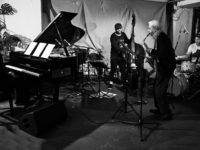Anthony Braxton’s been known to make a ‘standards’ record from time to time (especially during the mid 70s, mid 80s and mid 90s), but here’s a rare time where standards are juxtaposed against original material on the same album. When Braxton recorded 1974’s Trio And Duet for Delmark Records’ avant-garde imprint Sackville, he was still fairly early into a since-celebrated career, having already firmly established himself as a force to be reckoned with. But Braxton came with a background heavily steeped in traditional forms of post-war jazz and as he reveled in tradition, he also demonstrated that the line from Charlie Parker, Charlie Mingus and Miles Davis to Cecil Taylor, Ornette Coleman and, well, Anthony Braxton, is an unbroken one.
That’s the message you could take from Trio And Duet. Most of the tracks are jazz standards, known by anyone who is at least moderately into the genre, and none of them will fail to recognize these songs as performed by Braxton. But Braxton doesn’t forsake his primary identity in the process, either.
In fact, the first track is classic Braxton. Performed with trumpeter (Wadada) Leo Smith and experimental keyboardist Richard Teitelbaum, the original “Composition 36: HM 421 (RTS) 47” is a mixture of ‘new’ music, improv jazz, minimalism and 20th century classical, a piece that these days would be called “electro-acoustic,” largely thanks to Teitelbaum’s Moog synthesizer. With all three playing a wide array of instruments on a piece performed ‘live’ in the studio, the nineteen minute performance moves at an organic pace over a barren landscape. Even today it strikes one as being at the frontier of avant-garde.
The rest of the fare is the “Duet” part, standards performed by Braxton on his main instrument the alto sax with Dave Holland, his frequent partner on bass throughout the 70s. Nothing feels missing from “The Song Is You,” as Holland distributes notes in a swinging pulse that covers the underlying harmonics of the song so well, you could easily recognize it without Braxton. Braxton himself plays with old school verve, finding new ways to express the melody at each bar, and his solo is staggering, rapidly hitting every note bang on and always making the right choice.
Braxton delivers another superb sax performance on “Embraceable You,” but Holland grabs more of the spotlight this time, ignoring tempo to grab a share of the lead chores, showing much affinity with his old Circle band mate. Braxton’s sax suppleness suggests a walk outside at times during “You Go to My Head” but never fully commits to it, while Holland is swinging his ass off.
Two previously unreleased tracks from the same sessions are added for this January 2015 reissue; the “On Green Dolphin Street” and “I Remember You” takes maintain the overall quality of the originally released album. On the former Holland mixes it up during Braxton’s improv break, a torrent of notes that preserves the main thrust of the song. For “I Remember You,” Braxton substitutes more notes on the head than on the other standards, diverging a bit from his mostly straight-laced approach to these classic tunes.
Braxton’s paradox as a highly original, creative artist who pays earnest fealty to the classic strains of an earlier era comes in sharp relief. But to understand Anthony Braxton is to understand that there is no contradiction between these two features of him.




“When Braxton recorded 1974’s Trio And Duet for Delmark Records’ avante-garde [sic] imprint Sackville…”
A clarification: Delmark & Sackville were totally separate, unrelated labels; Delmark acquired the Sackville catalog (or distribution rights thereto) sometime around 2010-11.